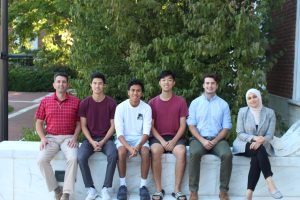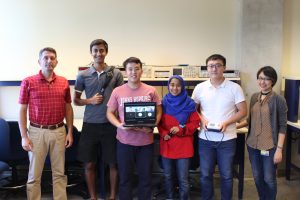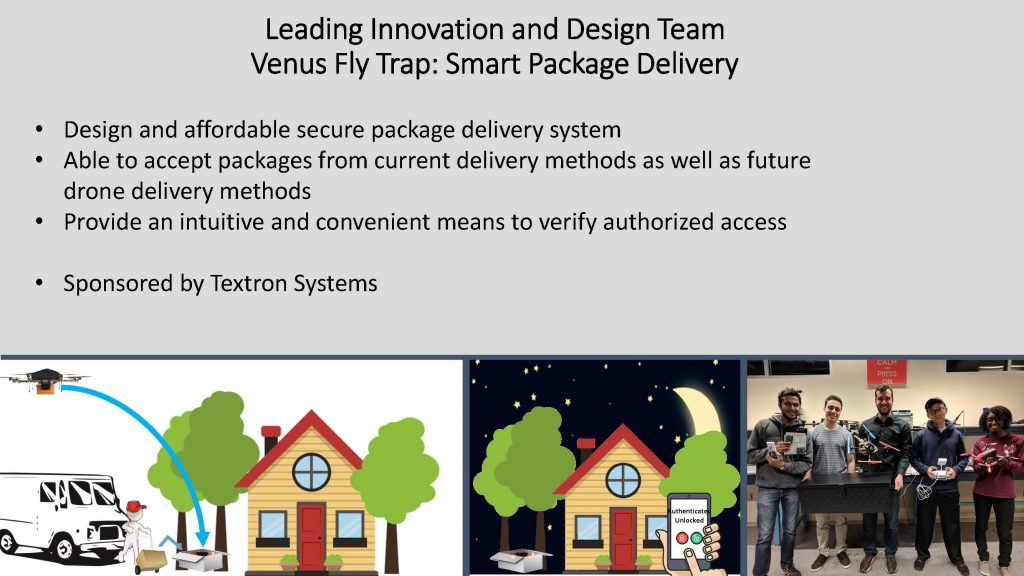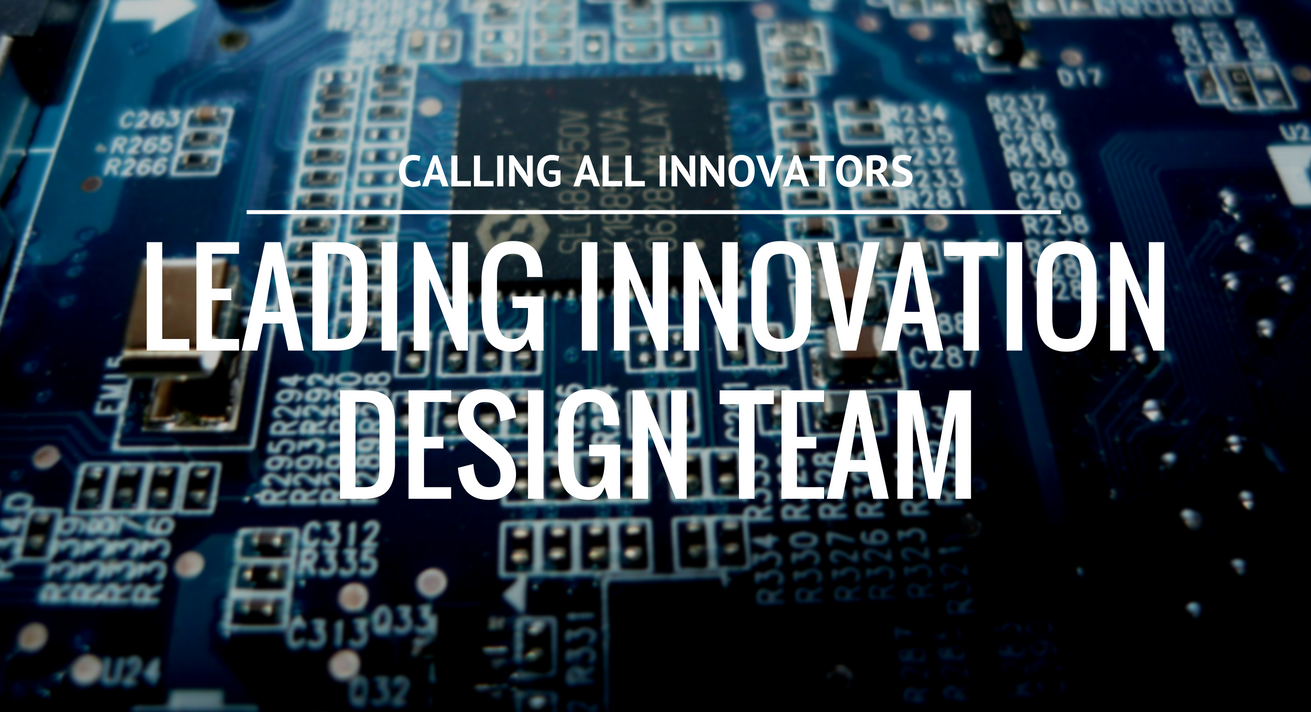[tabs class=”yourcustomclass”]
[tab title=”2021-2022″]
[panel style=”panel-default”]
[panel-header]
Check this page regularly as more projects will be announced!
[panel style=”panel-default”]
[panel-header]
iRoam
[/panel-header]
[panel-content]
The Opportunity: How many people are blind? It may shock you as well to learn it is a very large number. You may also find it surprising how little, if any, technology has been developed to help improve the quality of life for the visually impaired. If we are close to deploying fully autonomous vehicles, it would be reasonable to assume that we should be much closer to having an aid that can help visually impaired individuals safely navigate the streets and more. We are up for this challenge, how about you? The iRoam team has taken this challenge and in collaboration with the National Federation of the Blind is developing an innovative solution that will be prototyped next semester and tested in the city of Baltimore. If you are looking for a great learning experience and to making a great societal impact, this is your opportunity. Students who are interested, should email their transcripts and resume to Prof. Andreas Andreou.
[panel style=”panel-default”]
[panel-header]
[/panel-content]
[/panel]
[panel style=”panel-default”]
[panel-header]
ThermoBeat
[/panel-header]
[panel-content]
The Opportunity: Do you know anyone who has an implantable device? If so, did you know that these individuals go through multiple surgeries in their lifetime to have these devices replaced? Each surgery comes with an ever-increasing cost and risk. Did you ever wonder why that is the case? Here’s an example that may be shocking. The number one case for replacing pacemakers is the depletion of the battery. The ThermoBeat Team has taking on this challenge and in collaboration with APL is developing an implantable energy harvesting device to power the pacemaker as well as other devices. If you are looking for a great learning experience and to making a great societal impact, this is your opportunity. Students who are interested, should email their transcripts and resume to Prof. Andreas Andreou.
[/panel-content]
[/panel]
[/tab]
[tab title=”2020-2021″]
[panel style=”panel-default”]
[panel-header]
Check this page regularly as more projects will be announced!
[panel style=”panel-default”]
[panel-header]
iRoam
[/panel-header]
[panel-content]
The Opportunity: How many people are blind? It may shock you as well to learn it is a very large number. You may also find it surprising how little, if any, technology has been developed to help improve the quality of life for the visually impaired. If we are close to deploying fully autonomous vehicles, it would be reasonable to assume that we should be much closer to having an aid that can help visually impaired individuals safely navigate the streets and more. We are up for this challenge, how about you? The iRoam team has taken this challenge and in collaboration with the National Federation of the Blind is developing an innovative solution that will be prototyped next semester and tested in the city of Baltimore. If you are looking for a great learning experience and to making a great societal impact, this is your opportunity.
[panel style=”panel-default”]
[panel-header]
[/panel-content]
[/panel]
[panel style=”panel-default”]
[panel-header]
ThermoBeat
[/panel-header]
[panel-content]
The Opportunity: Do you know anyone who has an implantable device? If so, did you know that these individuals go through multiple surgeries in their lifetime to have these devices replaced? Each surgery comes with an ever-increasing cost and risk. Did you ever wonder why that is the case? Here’s an example that may be shocking. The number one case for replacing pacemakers is the depletion of the battery. The ThermoBeat Team has taking on this challenge and in collaboration with APL is developing an implantable energy harvesting device to power the pacemaker as well as other devices. If you are looking for a great learning experience and to making a great societal impact, this is your opportunity.
[/panel-content]
[/panel]
[/tab]
[tab title=”2019-2020″]
[panel style=”panel-default”]
[panel-header]
[panel style=”panel-default”]
[panel-header]
iRoam
[/panel-header]
[panel-content]
The Opportunity: Due to popular demand, the following project will be taking place for the Leading Innovation Design Team in the Spring of 2020. How many people are blind? It may shock you as well to learn it is a very large number. You may also find it surprising how little, if any, technology has been developed to help improve the quality of life for the visually impaired. If we are close to deploying fully autonomous vehicles, it would be reasonable to assume that we should be much closer to having an aid that can help visually impaired individuals safely navigate the streets and more. We are up for this challenge, how about you?
[panel style=”panel-default”]
[panel-header]
Decon
[/panel-header]
[panel-content]
The Opportunity: Healthcare associated infections (HAI) are dangerous and expensive. About 1.7 million people acquire infections in hospitals each year, resulting in about 100,000 deaths and direct annual medical costs of at least $28 billion. Autonomous systems used to decontaminate surfaces, air, and other transmission vectors have the potential to dramatically reduce risks and costs in a wide range of clinical settings. We are calling on all JHU innovators to develop robots that autonomously detect and disinfect healthcare facilities and assess how such systems can be cost-effectively deployed while assuring that they operate safely and effectively. This project is best suited for the Hopkins community as it spans two of our strongest areas: medical and robotics.
Sponsor: JHU Applied Physics Lab (JHU APL).

[/panel-content]
[/panel]
[panel style=”panel-default”]
[panel-header]
Sepsis Detection
[/panel-header]
[panel-content]
The Opportunity: Sepsis is a life-threatening condition that arises when the body’s response to an infection. It can rapidly cause tissue damage, organ failure and death. This project involves designing hardware or software tools that can help users conduct early diagnosis for their probability of Sepsis infection based on their inputs and also can offer them some advice, or to help patients keep tracking of their Sepsis treatment and symptoms by collecting data in different phase of the treatment to help improving their health condition.
Sponsor: Dr. Jim Fackler, Director of the Pediatric Critical Care and Associate Professor of Anesthesiology and Critical Care Medicine.

[/panel-content]
[/panel]
[panel style=”panel-default”]
[panel-header]
evGrand Prix
[/panel-header]
[panel-content]
The Opportunity: Calling on all the racing, robotics, and AI enthusiasts, the JHU Innovation community is about to take on another Grand Challenge: The evGrand Prix. Who’s in?
Sponsor: ECE Lindt & ME Senior Design.

[/panel-content]
[/panel]
[/tab]
[tab title=”2018-2019″]
[panel style=”panel-default”]
[panel-header]
Sepsis Here We Come
[/panel-header]
[panel-content]
Sepsis is a life-threatening condition that arises when the body’s response to an infection. It can rapidly cause tissue damage, organ failure and death. This project involves designing hardware or software tools that can help users conduct early diagnosis for their probability of Sepsis infection based on their inputs and also can offer them some advice, or to help patients keep tracking of their Sepsis treatment and symptoms by collecting data in different phase of the treatment to help improving their health condition.
[/panel-content]
[/panel]
[panel style=”panel-default”]
[panel-header]
Portable Personal Detection Device
[/panel-header]
[panel-content]
There is significant health risk associated with food allergies. Unfortunately, that issue has become more common in recent times and there is an urgent need for a consumer device that can scan and detect allergenic foods such as peanuts, lactose, and gluten to name a few. Although the need is age old, until recently there was no viable technology to enable a low cost, size, weight, and power solution. However, recent developments in imaging and processing technologies are showing a promising path towards such a solution. In particular, multi- and hyper-spectral imaging has shown the ability to detect and classify various chemical markers.
[/panel-content]
[/panel]
[panel style=”panel-default”]
[panel-header]
Low-level Light Therapy[/panel-header]
[panel-content]
Low-level light therapy consists of lasers or light emitting diodes at near-infrared wavelengths. At the status quo, LLLT devices are marketed as skin wound therapy, hair growth, and pain relief devices. It emits near-infrared light around 780nm near the surface of a skin where mitochondrial chromophores absorb photons. This causes a chain reaction of electron transport and ATP nitric oxide release, leading to signaling pathways. Ultimately signaling pathways activate stem cells leading to tissue repair and prevention of cell suicide.
[/panel-content]
[/panel]
[panel style=”panel-default”]
[panel-header]
NGC Radar Project[/panel-header]
[panel-content]
There has been an age-old debate between radio-frequency (i.e. radar) versus optical (camera, lidar) sensing. The excitement on this debate has significantly increased in recent years because of the autonomous application space as well as physical security. There is an ever-greater demand for better sensor data to support higher identification and discrimination/classification with acceptable confidence levels. The main advantages of RF sensors over optical are: the “all-weather” capability, the lack of a privacy issue, and large FOV. They can also provide velocity and distance.
[/panel-content]
[/panel]
[panel style=”panel-default”]
[panel-header]
Barcoding Warehouse Tracking[/panel-header]
[panel-content]
Online shopping is a way of life of many of us and we simply take for granted the easiness of ordering and receiving our wish list. A critical part of this cycle is warehouse inventory management. Keeping track of what and where is a highly dynamic environment is a significant joggling task. Currently, most warehouses require workers to walk the aisle and scan all the pallets for a cycle count or physical inventory of materials. This is a time-consuming process and not very robust. Automation is likely more efficient and reduces human error.
[/panel-content]
[/panel]
[/tab]
[tab title=”2017-2018″]
[panel style=”panel-default”]
[panel-header]
Hopkins Delivers
[/panel-header]
[panel-content]
Research on the viability of commercial drone transportation and delivery has rapidly accelerated in the last five years. The team have developed a prototype for an autonomous drone food delivery system on the Hopkins Homewood campus. Combining obstacle avoidance algorithms, proprietary safety features, and pick-up mechanisms, the system is built for ease-of-use for delivery vendors and students alike.
[/panel-content]
[/panel]
[panel style=”panel-default”]
[panel-header]Robotic Lawnmower
[/panel-header]
[panel-content]
If you are looking to earn the bragging rights to a cool product that brings people the joy of having a nicely trimmed lawn, this project is for you. You will work closely with the innovation team at Stanley Black & Decker to develop one of the world’s smartest robotic lawn mowers. As a bonus, you also give yourself a shot at getting hired by the B&D’s innovation team.
[/panel-content]
[/panel]
[panel style=”panel-default”]
[panel-header]Venus Fly Trap
[/panel-header]
[panel-content]
The Venus Fly Trap is a scalable, secure package delivery container able to accept deliveries from traditional couriers such as the United States Postal Service, United Parcel Service, FedEx, etc., as well as drone delivery from e-commerce providers such as Amazon. The Venus Fly Trap container is anchored at a customer designated location and, upon delivery of a package, will send a notification to the recipient that a package is awaiting pickup along with a recovery code to open the container. This solution is scalable from individual mailboxes to banks of containers serving large communities. Venus Fly Trap shall accommodate packages up to 2’x2’x2’ in size. Refrigerated containers are also an option for food delivery services such as Blue Apron.
[/panel-content]
[/panel]
[panel style=”panel-default”]
[panel-header]
Textron V1
[/panel-header]
[panel-content]
[/panel-content]
[/panel]
[/tab]
[/tabs]
